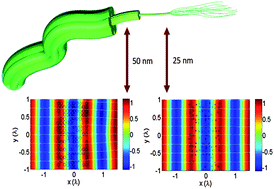Transparent nanopaper with tailored optical properties†
Abstract
Nanopaper is a flexible, transparent, and renewable substrate that is emerging as a replacement for plastic in printed “green” electronics. The underlying science of transparency of nanopaper is that the diameter of these fibers is much smaller than the light wavelength, which significantly decreases the light scattering as compared to regular fibers. Cellulose fibers have a hierarchical structure, which consists of numerous smaller fibers. In this manuscript, we demonstrate a nanopaper design with different fiber diameters, and conclude that the light transmittance and scattering depend on the fiber diameter and packing density. The optical properties of the nanopaper and their dependence on the cellulose fiber diameter are thoroughly explained through Chandrasekhar's radiative-transfer theory and multiple scattering method simulations. The controllable optical properties of highly transparent nanopaper present an unprecedented opportunity for growth of next-generation optoelectronics.


 Please wait while we load your content...
Please wait while we load your content...